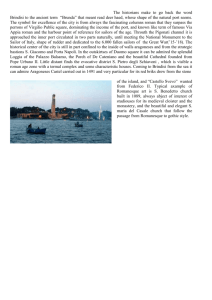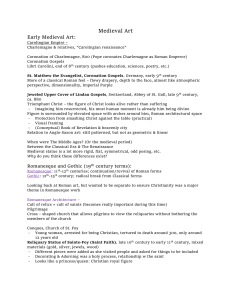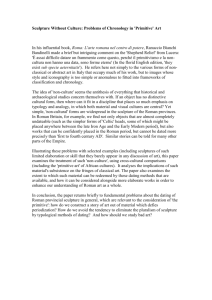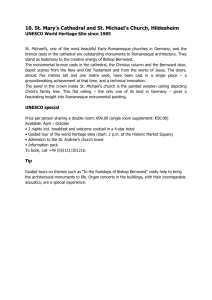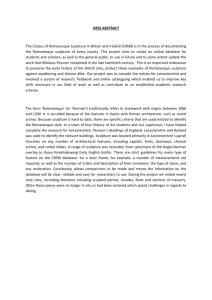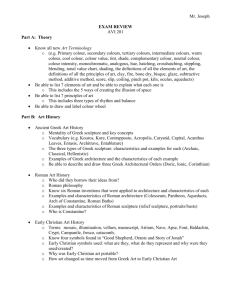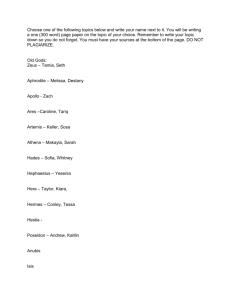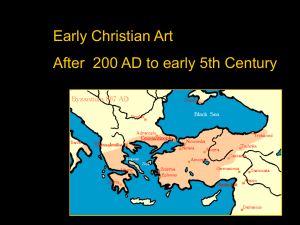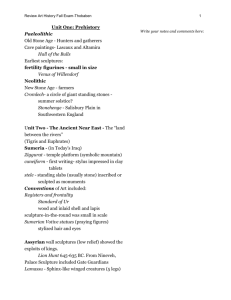Art 260 Ancient to Medieval Art Final Exam Study
advertisement
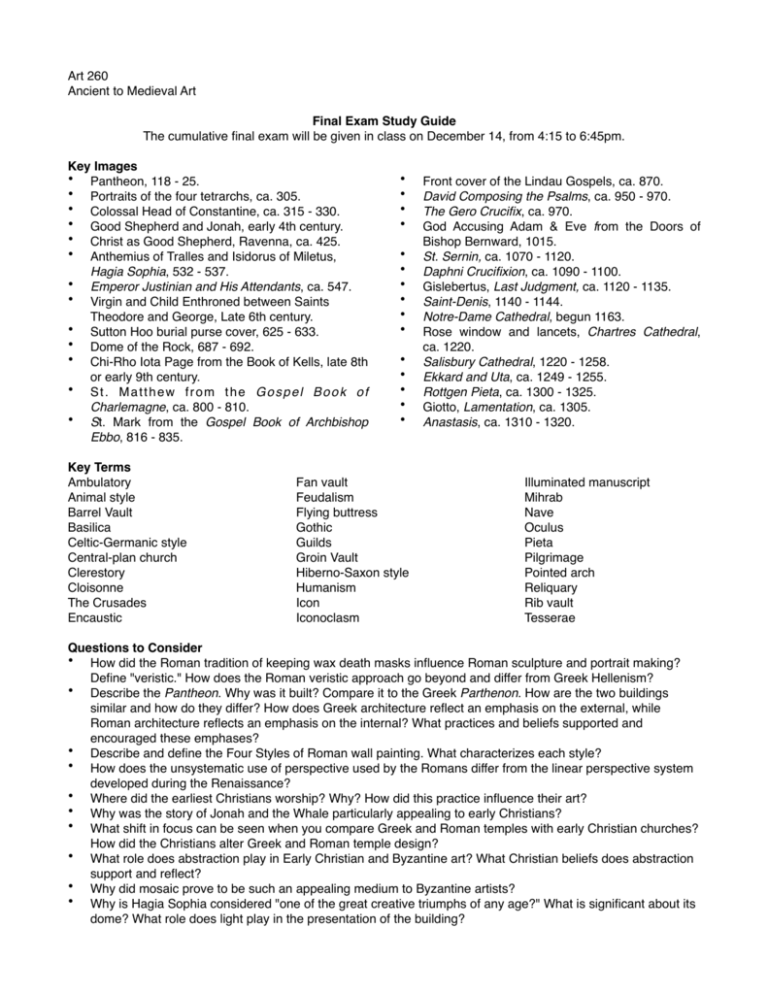
Art 260 Ancient to Medieval Art Final Exam Study Guide The cumulative final exam will be given in class on December 14, from 4:15 to 6:45pm. Key Images • Pantheon, 118 - 25. • Portraits of the four tetrarchs, ca. 305. • Colossal Head of Constantine, ca. 315 - 330. • Good Shepherd and Jonah, early 4th century. • Christ as Good Shepherd, Ravenna, ca. 425. • Anthemius of Tralles and Isidorus of Miletus, Hagia Sophia, 532 - 537. • Emperor Justinian and His Attendants, ca. 547. • Virgin and Child Enthroned between Saints Theodore and George, Late 6th century. • Sutton Hoo burial purse cover, 625 - 633. • Dome of the Rock, 687 - 692. • Chi-Rho Iota Page from the Book of Kells, late 8th or early 9th century. • St. Matthew from the Gospel Book of Charlemagne, ca. 800 - 810. • St. Mark from the Gospel Book of Archbishop Ebbo, 816 - 835. Key Terms Ambulatory Animal style Barrel Vault Basilica Celtic-Germanic style Central-plan church Clerestory Cloisonne The Crusades Encaustic • • • • • • • • • • • • • • • Fan vault Feudalism Flying buttress Gothic Guilds Groin Vault Hiberno-Saxon style Humanism Icon Iconoclasm Front cover of the Lindau Gospels, ca. 870. David Composing the Psalms, ca. 950 - 970. The Gero Crucifix, ca. 970. God Accusing Adam & Eve from the Doors of Bishop Bernward, 1015. St. Sernin, ca. 1070 - 1120. Daphni Crucifixion, ca. 1090 - 1100. Gislebertus, Last Judgment, ca. 1120 - 1135. Saint-Denis, 1140 - 1144. Notre-Dame Cathedral, begun 1163. Rose window and lancets, Chartres Cathedral, ca. 1220. Salisbury Cathedral, 1220 - 1258. Ekkard and Uta, ca. 1249 - 1255. Rottgen Pieta, ca. 1300 - 1325. Giotto, Lamentation, ca. 1305. Anastasis, ca. 1310 - 1320. Illuminated manuscript Mihrab Nave Oculus Pieta Pilgrimage Pointed arch Reliquary Rib vault Tesserae Questions to Consider • How did the Roman tradition of keeping wax death masks influence Roman sculpture and portrait making? Define "veristic." How does the Roman veristic approach go beyond and differ from Greek Hellenism? • Describe the Pantheon. Why was it built? Compare it to the Greek Parthenon. How are the two buildings similar and how do they differ? How does Greek architecture reflect an emphasis on the external, while Roman architecture reflects an emphasis on the internal? What practices and beliefs supported and encouraged these emphases? • Describe and define the Four Styles of Roman wall painting. What characterizes each style? • How does the unsystematic use of perspective used by the Romans differ from the linear perspective system developed during the Renaissance? • Where did the earliest Christians worship? Why? How did this practice influence their art? • Why was the story of Jonah and the Whale particularly appealing to early Christians? • What shift in focus can be seen when you compare Greek and Roman temples with early Christian churches? How did the Christians alter Greek and Roman temple design? • What role does abstraction play in Early Christian and Byzantine art? What Christian beliefs does abstraction support and reflect? • Why did mosaic prove to be such an appealing medium to Byzantine artists? • Why is Hagia Sophia considered "one of the great creative triumphs of any age?" What is significant about its dome? What role does light play in the presentation of the building? • • • • • • • • • • • • • • • • • • • • • • • • • • Why do we so little sculpture during the Early Christian period? How do images of Christ change over time? What meanings and associations do these changes reflect? On what kind of objects do we usually find animal style art? How does this relate to the peoples who developed the style and the way they lived? What four motifs do we find on the Purse Cover from the Sutton Hoo ship burial? What influences do they reflect? What previous civilizations can we trace them back to? What was the chief medium of the animal style? How did this encourage its wide spread influence? Where did the animal style flourish longest? What influence did the animal style have on the illuminated manuscripts produced primarily in Ireland during the early Middle Ages? How plentiful were books in the Middle Ages? Who owned books? Who created books? What purpose did most books created at this time serve? What previous emperors did Charlemagne model himself after? How did this influence his support of the arts? What were Charlemagne's goals? What was the "Carolingian revival" and what was its impact on art? What is the Biblical basis of monasticism? What did monastic life emphasize? What did the eventual conflict between work and poverty lead to? What were the Franciscans and the Dominicans devoted to? How did Franciscan monks first live? Define “mendicant.” Where was the spiritual and cultural center of the western world located in the early Middle Ages? What role did monasteries play in this? Had this area ever been part of the Roman Empire? What does the Plan of a Monastery tell us about the importance of monasteries and their link to the Imperial court? What became of the Holy Roman Empire after Charlemagne's death? How did these events lead to the feudal system in the late ninth and early tenth centuries? How did the feudal system work? Where were artists located in this system? How is Christ portrayed on the bronze Doors of Bishop Bernward? What influences do the sculpted relief panels reflect? Describe the manner in which Adam and Eve are portrayed. What does the term "Romanesque" mean? What distinguishes Romanesque from early medieval works? What Roman elements were used in Romanesque style churches? What was a pilgrimage? How did it influence medieval culture, trade and art? Who called for the first pilgrimage? When and why? What is a "pointed arch?" Where did it likely come from? What does its use allow for? What lightweight, flexible system for covering broad expanses was realized in Durham Cathedral? Why do we rarely find monumental stone sculpture after the 5th century? What likely brought about its revival? Who does architectural sculpture appeal to? How is a stone-carved, three-dimensional image more "real" than a painted one? Describe flexibility and agitation as it relates to Romanesque sculpture. What matters most? What does a tympanum of the main portal of Romanesque churches usually depict? Describe the composition of Giselbertus' Last Judgment? How is this a fear-inducing image? What special meaning did the Mission of the Apostles have for the middle ages? What common qualities do the sculptures of Moissac, Autun and Vezelay have? How does this approach to sculpture relate to illuminated manuscripts? How did the artist Wiligelmo feel about his work? Are signatures rare in Romanesque works? How does the emergence of distinct artistic personalities conflict with popular notions of medieval art? What is a buttress? What does the use of buttressing allow for?
